Global Economy Analysis: MAE203 Assignment, Trimester 1, 2019
VerifiedAdded on 2023/01/18
|7
|1838
|100
Homework Assignment
AI Summary
This assignment analyzes the global economy, focusing on the relationship between real GDP growth and unemployment, nominal GDP growth and inflation, and the patterns of inflation and unemployment in Australia. It also explores the factors influencing aggregate expenditure and discusses the impact of supply shocks on an economy, including both short-run and long-run effects. The assignment includes data analysis, graphical representations, and short answer explanations, adhering to the requirements of the MAE203 course, emphasizing data collection, presentation, and analytical skills. Furthermore, it briefly touches upon consumer confidence and the effects of interest rates on investment and consumption. The student utilizes graphs and economic models to explain the concepts and relationships discussed.
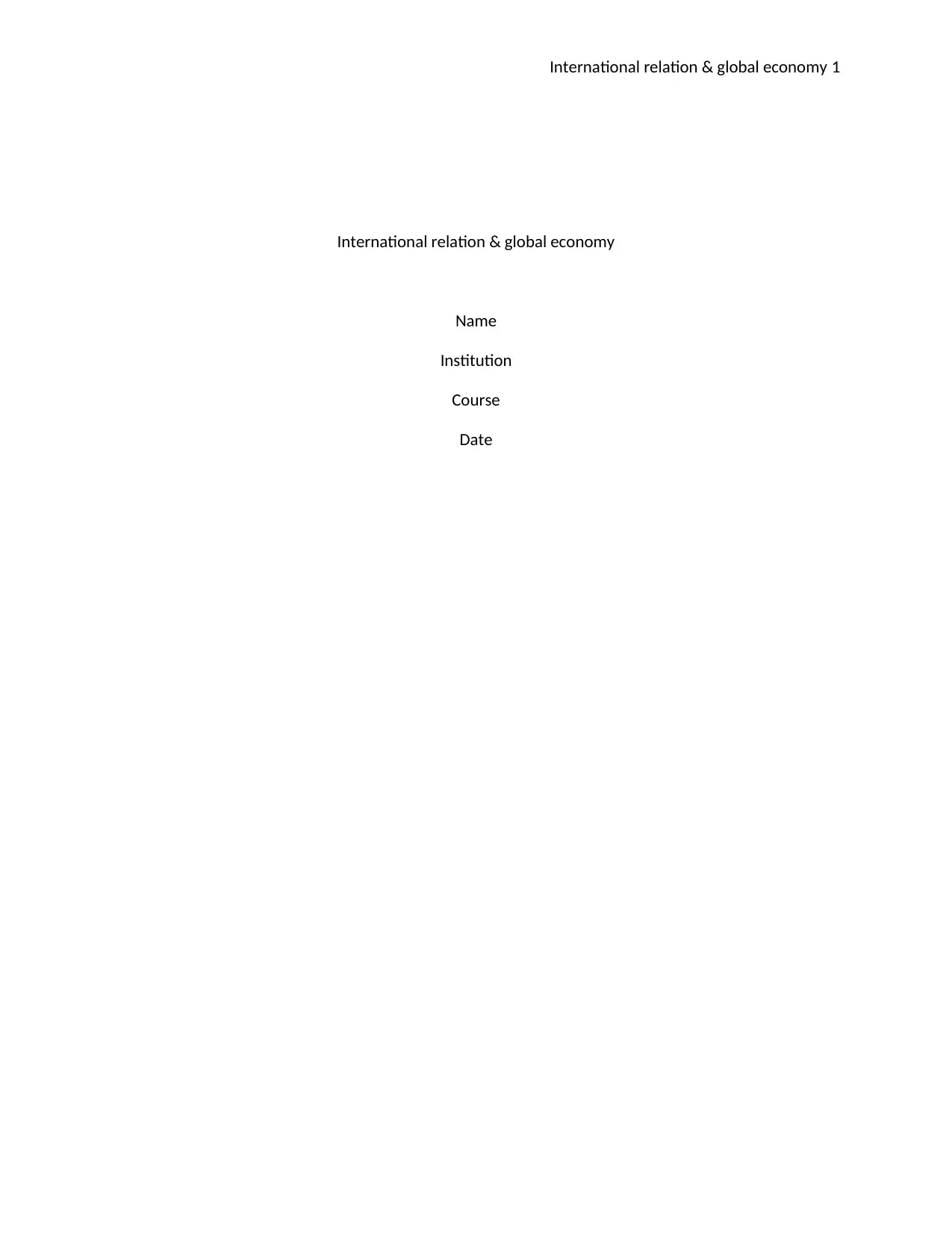
International relation & global economy 1
International relation & global economy
Name
Institution
Course
Date
International relation & global economy
Name
Institution
Course
Date
Paraphrase This Document
Need a fresh take? Get an instant paraphrase of this document with our AI Paraphraser
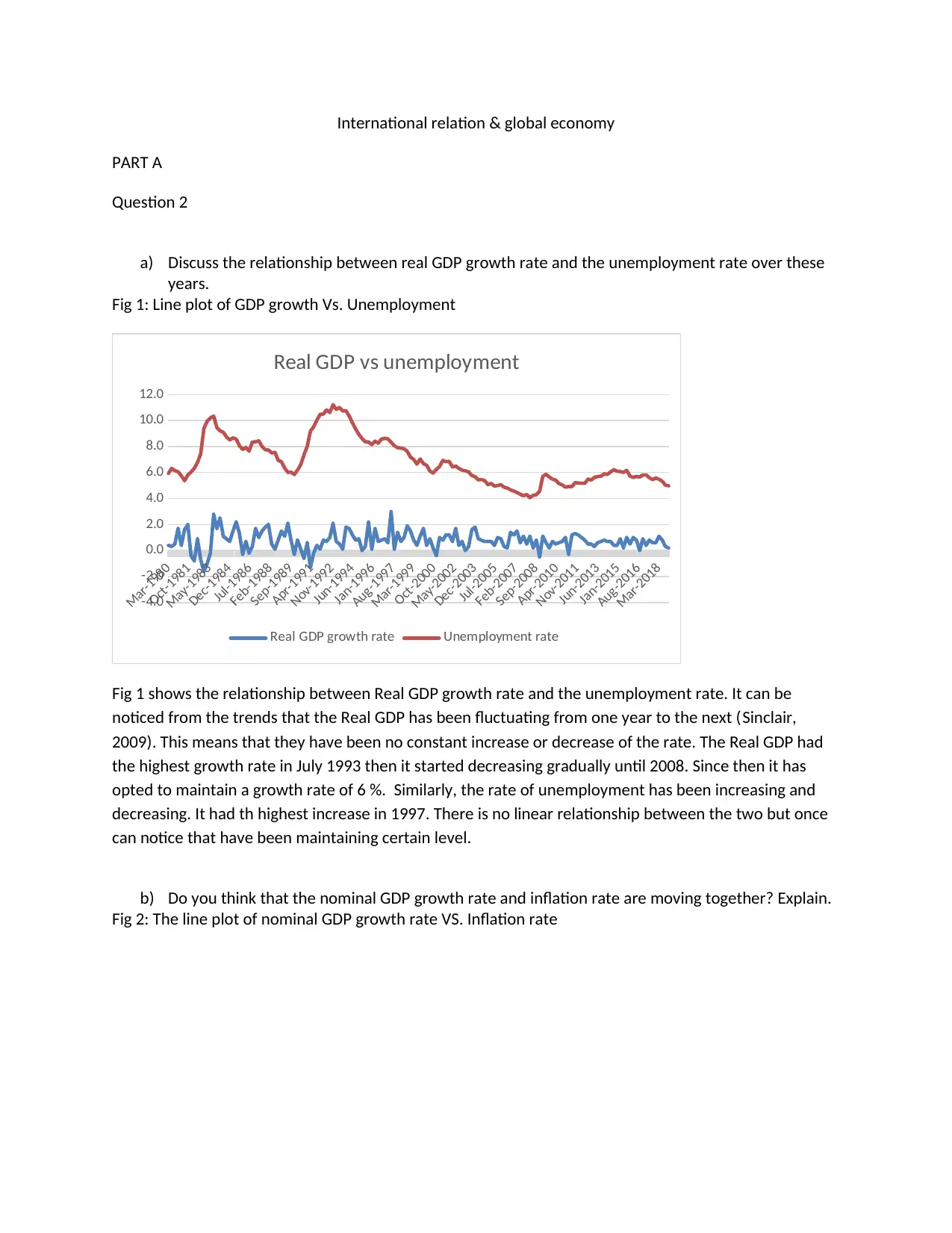
International relation & global economy
PART A
Question 2
a) Discuss the relationship between real GDP growth rate and the unemployment rate over these
years.
Fig 1: Line plot of GDP growth Vs. Unemployment
Mar-1980
Oct-1981
May-1983
Dec-1984
Jul-1986
Feb-1988
Sep-1989
Apr-1991
Nov-1992
Jun-1994
Jan-1996
Aug-1997
Mar-1999
Oct-2000
May-2002
Dec-2003
Jul-2005
Feb-2007
Sep-2008
Apr-2010
Nov-2011
Jun-2013
Jan-2015
Aug-2016
Mar-2018
-4.0
-2.0
0.0
2.0
4.0
6.0
8.0
10.0
12.0
Real GDP vs unemployment
Real GDP growth rate Unemployment rate
Fig 1 shows the relationship between Real GDP growth rate and the unemployment rate. It can be
noticed from the trends that the Real GDP has been fluctuating from one year to the next (Sinclair,
2009). This means that they have been no constant increase or decrease of the rate. The Real GDP had
the highest growth rate in July 1993 then it started decreasing gradually until 2008. Since then it has
opted to maintain a growth rate of 6 %. Similarly, the rate of unemployment has been increasing and
decreasing. It had th highest increase in 1997. There is no linear relationship between the two but once
can notice that have been maintaining certain level.
b) Do you think that the nominal GDP growth rate and inflation rate are moving together? Explain.
Fig 2: The line plot of nominal GDP growth rate VS. Inflation rate
PART A
Question 2
a) Discuss the relationship between real GDP growth rate and the unemployment rate over these
years.
Fig 1: Line plot of GDP growth Vs. Unemployment
Mar-1980
Oct-1981
May-1983
Dec-1984
Jul-1986
Feb-1988
Sep-1989
Apr-1991
Nov-1992
Jun-1994
Jan-1996
Aug-1997
Mar-1999
Oct-2000
May-2002
Dec-2003
Jul-2005
Feb-2007
Sep-2008
Apr-2010
Nov-2011
Jun-2013
Jan-2015
Aug-2016
Mar-2018
-4.0
-2.0
0.0
2.0
4.0
6.0
8.0
10.0
12.0
Real GDP vs unemployment
Real GDP growth rate Unemployment rate
Fig 1 shows the relationship between Real GDP growth rate and the unemployment rate. It can be
noticed from the trends that the Real GDP has been fluctuating from one year to the next (Sinclair,
2009). This means that they have been no constant increase or decrease of the rate. The Real GDP had
the highest growth rate in July 1993 then it started decreasing gradually until 2008. Since then it has
opted to maintain a growth rate of 6 %. Similarly, the rate of unemployment has been increasing and
decreasing. It had th highest increase in 1997. There is no linear relationship between the two but once
can notice that have been maintaining certain level.
b) Do you think that the nominal GDP growth rate and inflation rate are moving together? Explain.
Fig 2: The line plot of nominal GDP growth rate VS. Inflation rate
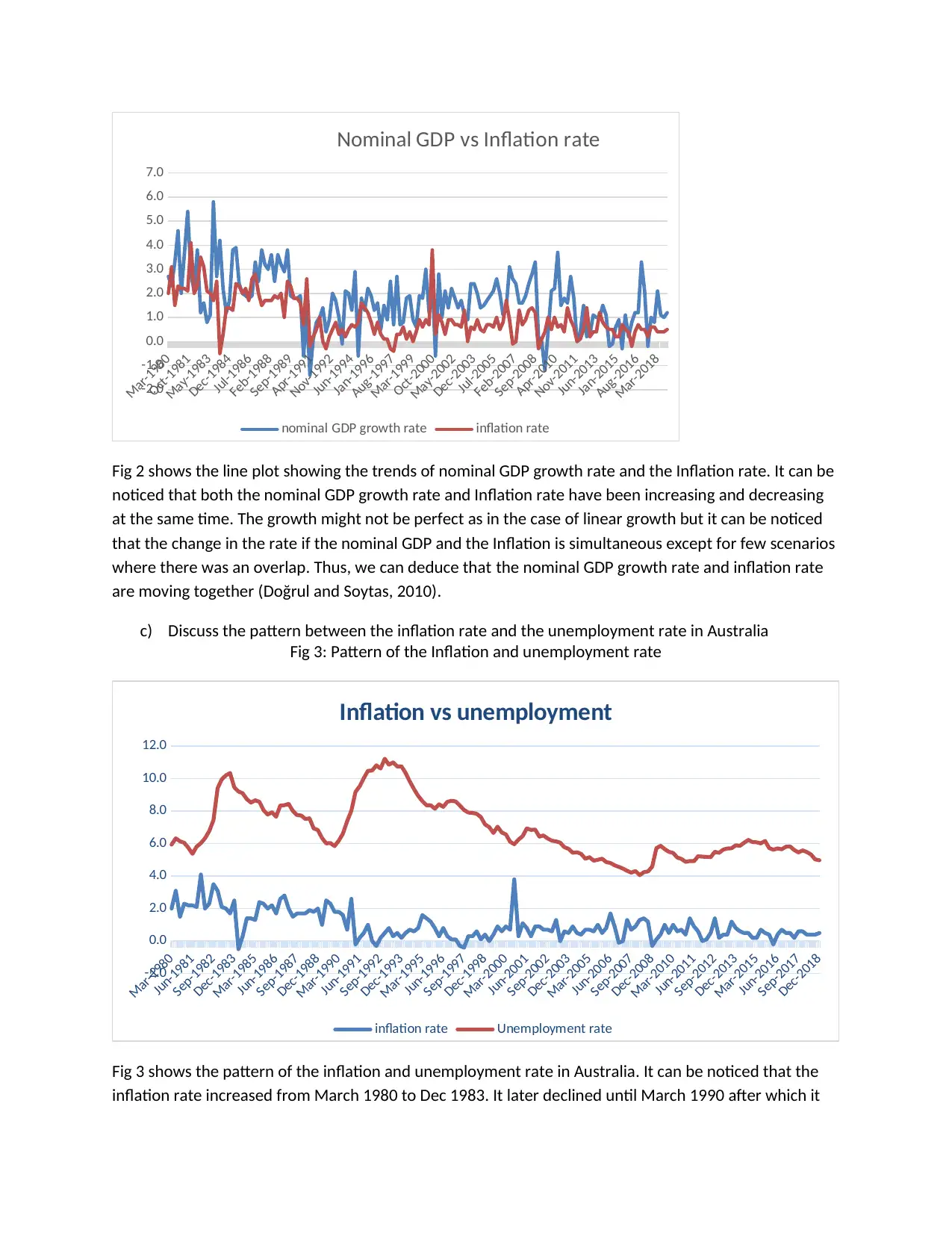
Mar-1980
Oct-1981
May-1983
Dec-1984
Jul-1986
Feb-1988
Sep-1989
Apr-1991
Nov-1992
Jun-1994
Jan-1996
Aug-1997
Mar-1999
Oct-2000
May-2002
Dec-2003
Jul-2005
Feb-2007
Sep-2008
Apr-2010
Nov-2011
Jun-2013
Jan-2015
Aug-2016
Mar-2018
-2.0
-1.0
0.0
1.0
2.0
3.0
4.0
5.0
6.0
7.0
Nominal GDP vs Inflation rate
nominal GDP growth rate inflation rate
Fig 2 shows the line plot showing the trends of nominal GDP growth rate and the Inflation rate. It can be
noticed that both the nominal GDP growth rate and Inflation rate have been increasing and decreasing
at the same time. The growth might not be perfect as in the case of linear growth but it can be noticed
that the change in the rate if the nominal GDP and the Inflation is simultaneous except for few scenarios
where there was an overlap. Thus, we can deduce that the nominal GDP growth rate and inflation rate
are moving together (Doğrul and Soytas, 2010).
c) Discuss the pattern between the inflation rate and the unemployment rate in Australia
Fig 3: Pattern of the Inflation and unemployment rate
Mar-1980
Jun-1981
Sep-1982
Dec-1983
Mar-1985
Jun-1986
Sep-1987
Dec-1988
Mar-1990
Jun-1991
Sep-1992
Dec-1993
Mar-1995
Jun-1996
Sep-1997
Dec-1998
Mar-2000
Jun-2001
Sep-2002
Dec-2003
Mar-2005
Jun-2006
Sep-2007
Dec-2008
Mar-2010
Jun-2011
Sep-2012
Dec-2013
Mar-2015
Jun-2016
Sep-2017
Dec-2018
-2.0
0.0
2.0
4.0
6.0
8.0
10.0
12.0
Inflation vs unemployment
inflation rate Unemployment rate
Fig 3 shows the pattern of the inflation and unemployment rate in Australia. It can be noticed that the
inflation rate increased from March 1980 to Dec 1983. It later declined until March 1990 after which it
Oct-1981
May-1983
Dec-1984
Jul-1986
Feb-1988
Sep-1989
Apr-1991
Nov-1992
Jun-1994
Jan-1996
Aug-1997
Mar-1999
Oct-2000
May-2002
Dec-2003
Jul-2005
Feb-2007
Sep-2008
Apr-2010
Nov-2011
Jun-2013
Jan-2015
Aug-2016
Mar-2018
-2.0
-1.0
0.0
1.0
2.0
3.0
4.0
5.0
6.0
7.0
Nominal GDP vs Inflation rate
nominal GDP growth rate inflation rate
Fig 2 shows the line plot showing the trends of nominal GDP growth rate and the Inflation rate. It can be
noticed that both the nominal GDP growth rate and Inflation rate have been increasing and decreasing
at the same time. The growth might not be perfect as in the case of linear growth but it can be noticed
that the change in the rate if the nominal GDP and the Inflation is simultaneous except for few scenarios
where there was an overlap. Thus, we can deduce that the nominal GDP growth rate and inflation rate
are moving together (Doğrul and Soytas, 2010).
c) Discuss the pattern between the inflation rate and the unemployment rate in Australia
Fig 3: Pattern of the Inflation and unemployment rate
Mar-1980
Jun-1981
Sep-1982
Dec-1983
Mar-1985
Jun-1986
Sep-1987
Dec-1988
Mar-1990
Jun-1991
Sep-1992
Dec-1993
Mar-1995
Jun-1996
Sep-1997
Dec-1998
Mar-2000
Jun-2001
Sep-2002
Dec-2003
Mar-2005
Jun-2006
Sep-2007
Dec-2008
Mar-2010
Jun-2011
Sep-2012
Dec-2013
Mar-2015
Jun-2016
Sep-2017
Dec-2018
-2.0
0.0
2.0
4.0
6.0
8.0
10.0
12.0
Inflation vs unemployment
inflation rate Unemployment rate
Fig 3 shows the pattern of the inflation and unemployment rate in Australia. It can be noticed that the
inflation rate increased from March 1980 to Dec 1983. It later declined until March 1990 after which it
⊘ This is a preview!⊘
Do you want full access?
Subscribe today to unlock all pages.

Trusted by 1+ million students worldwide

increased gradually to its highest point in September 1992 to December 1993. It later dropped to its
lowest in September 2007 to December 2008. Since then, it has maintained rate equal or less than 6 %.
Inflation rate have been increasing and decreasing without any steady rate. It increased to its highest in
between July 1981 to September 1982 and March 2000 to June 2001. It had the lowest rate in Dec 1983.
It can also be noticed that inflation rate has been maintain a rate less than 4 % (Berentsen, Menzio, and
Wright, 2011).
Part B
Question 3
The formula of obtaining aggregate expenditure is; Aggregate Expenditure = C + I + G + NX, where C is
the consumption, I is the investment, G is government spending, and NX is net exports which are exports
minus imports.
Normally, when the interest rate rises, the investment rises. This means that a rise in the interest rates
would lead to an increase in the amount obtained after investing.
Conversely, when the interest rates reduce, the investments also reduce. This is because the interest
rates do not interest the investors.
Similarly, if the interest rates increase, consumers may decide to reduce their consumption rate, and the
benefit of the investment will be lost since investing requires the consumers to spend (Dees and Brinca,
2013).
There is some scenario where a decrease in interest rates do not affect consumption and investment
spending:
1. Consumer confidence – This is when consumers are purchasing a greater amount of goods and
services regardless of their current financial status. This happens when they are confident about
the economic conditions and their future financial status, thus affecting the consumption of the
consumers regardless of the change in interest rates.
2. Consumer Invisible hand – It occurs when the consumer is directly linked to the producers. The
consumer engages in bidding before getting the goods. The scarce resources in the economy are
continuously arranged by the producer to the consumer. This raises the standards of consumers,
bringing more wealth to the consumer and their income remains the same. Even if the interest
rates reduce, it won't affect the consumer's investment and consumption spending.
Question 4
lowest in September 2007 to December 2008. Since then, it has maintained rate equal or less than 6 %.
Inflation rate have been increasing and decreasing without any steady rate. It increased to its highest in
between July 1981 to September 1982 and March 2000 to June 2001. It had the lowest rate in Dec 1983.
It can also be noticed that inflation rate has been maintain a rate less than 4 % (Berentsen, Menzio, and
Wright, 2011).
Part B
Question 3
The formula of obtaining aggregate expenditure is; Aggregate Expenditure = C + I + G + NX, where C is
the consumption, I is the investment, G is government spending, and NX is net exports which are exports
minus imports.
Normally, when the interest rate rises, the investment rises. This means that a rise in the interest rates
would lead to an increase in the amount obtained after investing.
Conversely, when the interest rates reduce, the investments also reduce. This is because the interest
rates do not interest the investors.
Similarly, if the interest rates increase, consumers may decide to reduce their consumption rate, and the
benefit of the investment will be lost since investing requires the consumers to spend (Dees and Brinca,
2013).
There is some scenario where a decrease in interest rates do not affect consumption and investment
spending:
1. Consumer confidence – This is when consumers are purchasing a greater amount of goods and
services regardless of their current financial status. This happens when they are confident about
the economic conditions and their future financial status, thus affecting the consumption of the
consumers regardless of the change in interest rates.
2. Consumer Invisible hand – It occurs when the consumer is directly linked to the producers. The
consumer engages in bidding before getting the goods. The scarce resources in the economy are
continuously arranged by the producer to the consumer. This raises the standards of consumers,
bringing more wealth to the consumer and their income remains the same. Even if the interest
rates reduce, it won't affect the consumer's investment and consumption spending.
Question 4
Paraphrase This Document
Need a fresh take? Get an instant paraphrase of this document with our AI Paraphraser
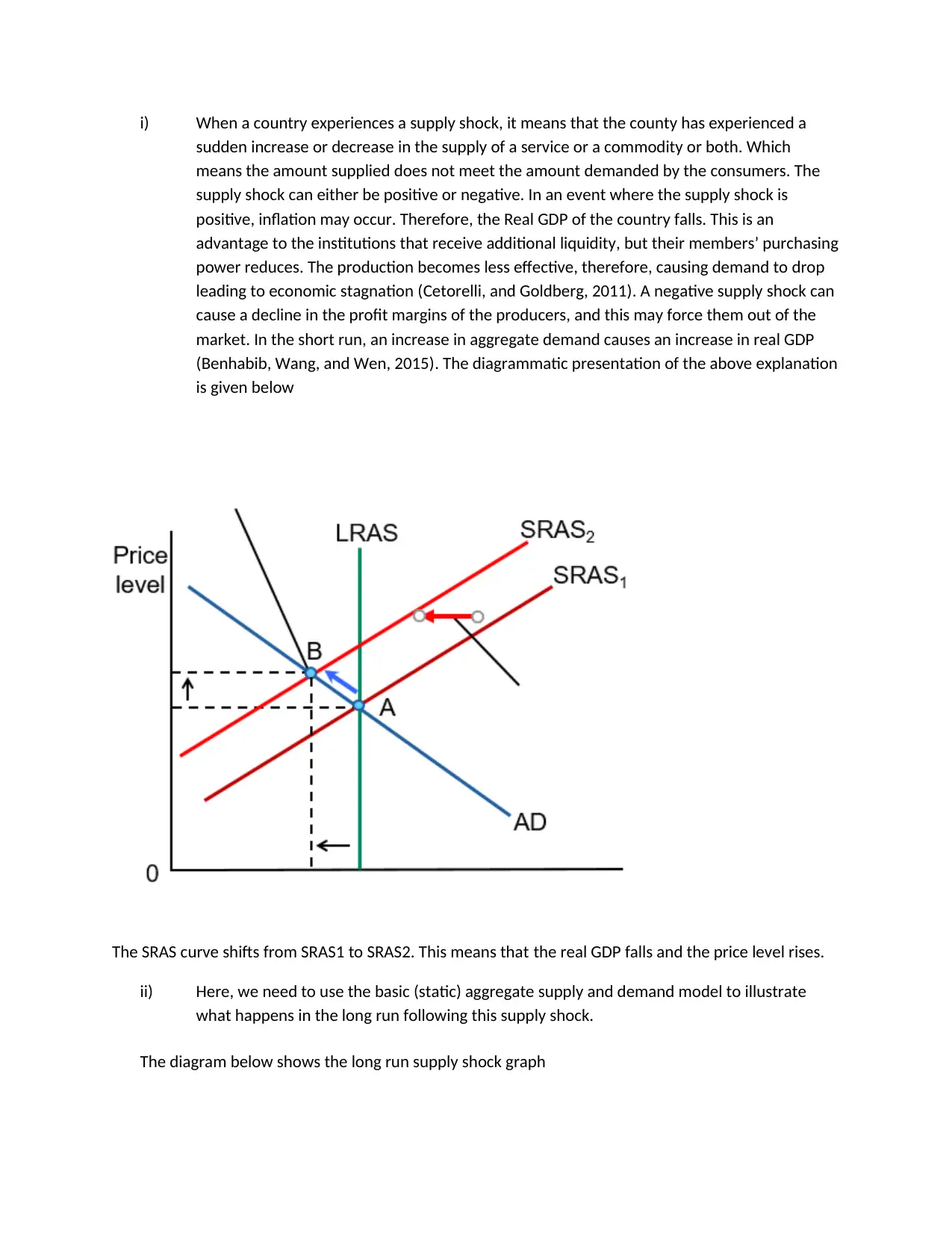
i) When a country experiences a supply shock, it means that the county has experienced a
sudden increase or decrease in the supply of a service or a commodity or both. Which
means the amount supplied does not meet the amount demanded by the consumers. The
supply shock can either be positive or negative. In an event where the supply shock is
positive, inflation may occur. Therefore, the Real GDP of the country falls. This is an
advantage to the institutions that receive additional liquidity, but their members’ purchasing
power reduces. The production becomes less effective, therefore, causing demand to drop
leading to economic stagnation (Cetorelli, and Goldberg, 2011). A negative supply shock can
cause a decline in the profit margins of the producers, and this may force them out of the
market. In the short run, an increase in aggregate demand causes an increase in real GDP
(Benhabib, Wang, and Wen, 2015). The diagrammatic presentation of the above explanation
is given below
The SRAS curve shifts from SRAS1 to SRAS2. This means that the real GDP falls and the price level rises.
ii) Here, we need to use the basic (static) aggregate supply and demand model to illustrate
what happens in the long run following this supply shock.
The diagram below shows the long run supply shock graph
sudden increase or decrease in the supply of a service or a commodity or both. Which
means the amount supplied does not meet the amount demanded by the consumers. The
supply shock can either be positive or negative. In an event where the supply shock is
positive, inflation may occur. Therefore, the Real GDP of the country falls. This is an
advantage to the institutions that receive additional liquidity, but their members’ purchasing
power reduces. The production becomes less effective, therefore, causing demand to drop
leading to economic stagnation (Cetorelli, and Goldberg, 2011). A negative supply shock can
cause a decline in the profit margins of the producers, and this may force them out of the
market. In the short run, an increase in aggregate demand causes an increase in real GDP
(Benhabib, Wang, and Wen, 2015). The diagrammatic presentation of the above explanation
is given below
The SRAS curve shifts from SRAS1 to SRAS2. This means that the real GDP falls and the price level rises.
ii) Here, we need to use the basic (static) aggregate supply and demand model to illustrate
what happens in the long run following this supply shock.
The diagram below shows the long run supply shock graph
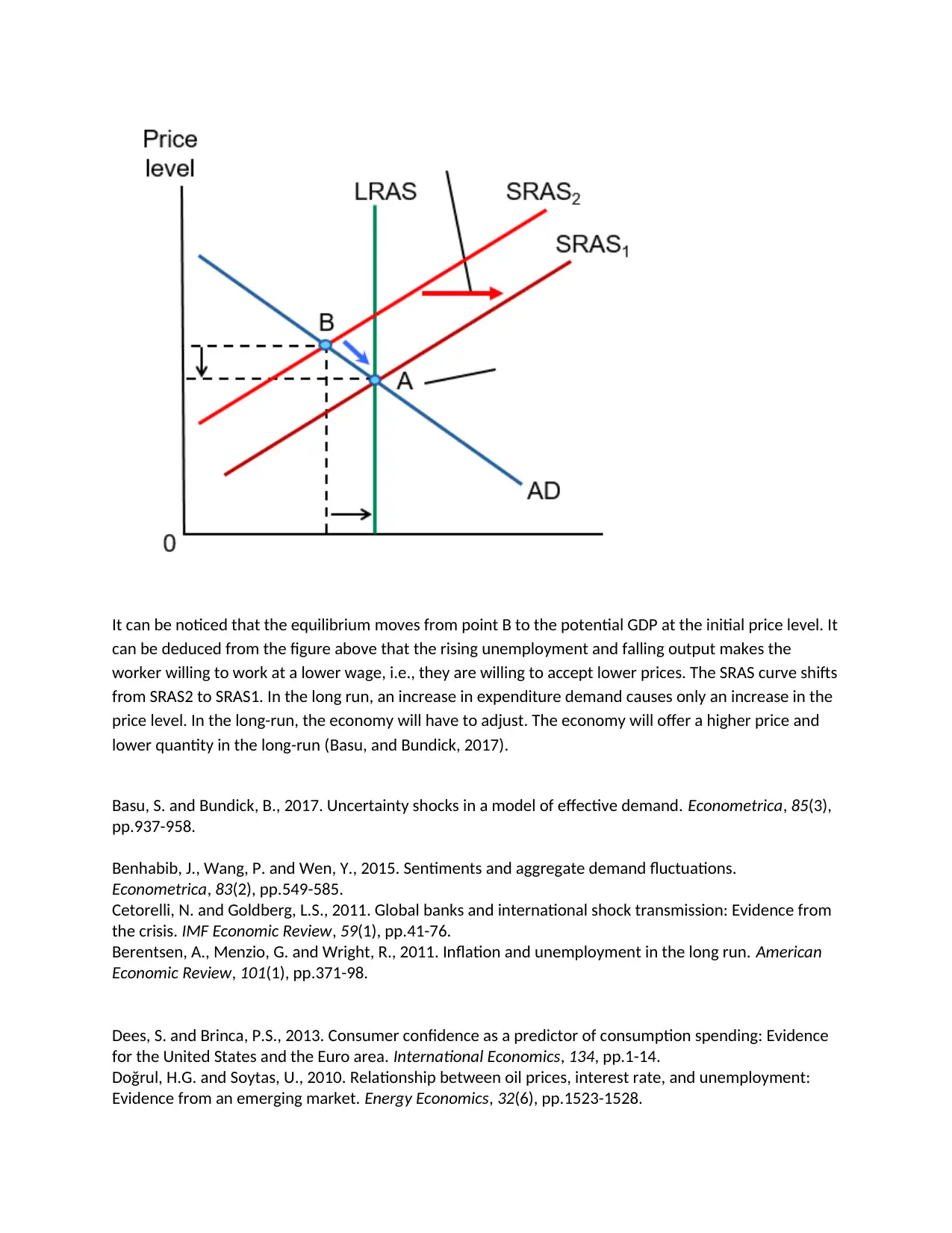
It can be noticed that the equilibrium moves from point B to the potential GDP at the initial price level. It
can be deduced from the figure above that the rising unemployment and falling output makes the
worker willing to work at a lower wage, i.e., they are willing to accept lower prices. The SRAS curve shifts
from SRAS2 to SRAS1. In the long run, an increase in expenditure demand causes only an increase in the
price level. In the long-run, the economy will have to adjust. The economy will offer a higher price and
lower quantity in the long-run (Basu, and Bundick, 2017).
Basu, S. and Bundick, B., 2017. Uncertainty shocks in a model of effective demand. Econometrica, 85(3),
pp.937-958.
Benhabib, J., Wang, P. and Wen, Y., 2015. Sentiments and aggregate demand fluctuations.
Econometrica, 83(2), pp.549-585.
Cetorelli, N. and Goldberg, L.S., 2011. Global banks and international shock transmission: Evidence from
the crisis. IMF Economic Review, 59(1), pp.41-76.
Berentsen, A., Menzio, G. and Wright, R., 2011. Inflation and unemployment in the long run. American
Economic Review, 101(1), pp.371-98.
Dees, S. and Brinca, P.S., 2013. Consumer confidence as a predictor of consumption spending: Evidence
for the United States and the Euro area. International Economics, 134, pp.1-14.
Doğrul, H.G. and Soytas, U., 2010. Relationship between oil prices, interest rate, and unemployment:
Evidence from an emerging market. Energy Economics, 32(6), pp.1523-1528.
can be deduced from the figure above that the rising unemployment and falling output makes the
worker willing to work at a lower wage, i.e., they are willing to accept lower prices. The SRAS curve shifts
from SRAS2 to SRAS1. In the long run, an increase in expenditure demand causes only an increase in the
price level. In the long-run, the economy will have to adjust. The economy will offer a higher price and
lower quantity in the long-run (Basu, and Bundick, 2017).
Basu, S. and Bundick, B., 2017. Uncertainty shocks in a model of effective demand. Econometrica, 85(3),
pp.937-958.
Benhabib, J., Wang, P. and Wen, Y., 2015. Sentiments and aggregate demand fluctuations.
Econometrica, 83(2), pp.549-585.
Cetorelli, N. and Goldberg, L.S., 2011. Global banks and international shock transmission: Evidence from
the crisis. IMF Economic Review, 59(1), pp.41-76.
Berentsen, A., Menzio, G. and Wright, R., 2011. Inflation and unemployment in the long run. American
Economic Review, 101(1), pp.371-98.
Dees, S. and Brinca, P.S., 2013. Consumer confidence as a predictor of consumption spending: Evidence
for the United States and the Euro area. International Economics, 134, pp.1-14.
Doğrul, H.G. and Soytas, U., 2010. Relationship between oil prices, interest rate, and unemployment:
Evidence from an emerging market. Energy Economics, 32(6), pp.1523-1528.
⊘ This is a preview!⊘
Do you want full access?
Subscribe today to unlock all pages.

Trusted by 1+ million students worldwide
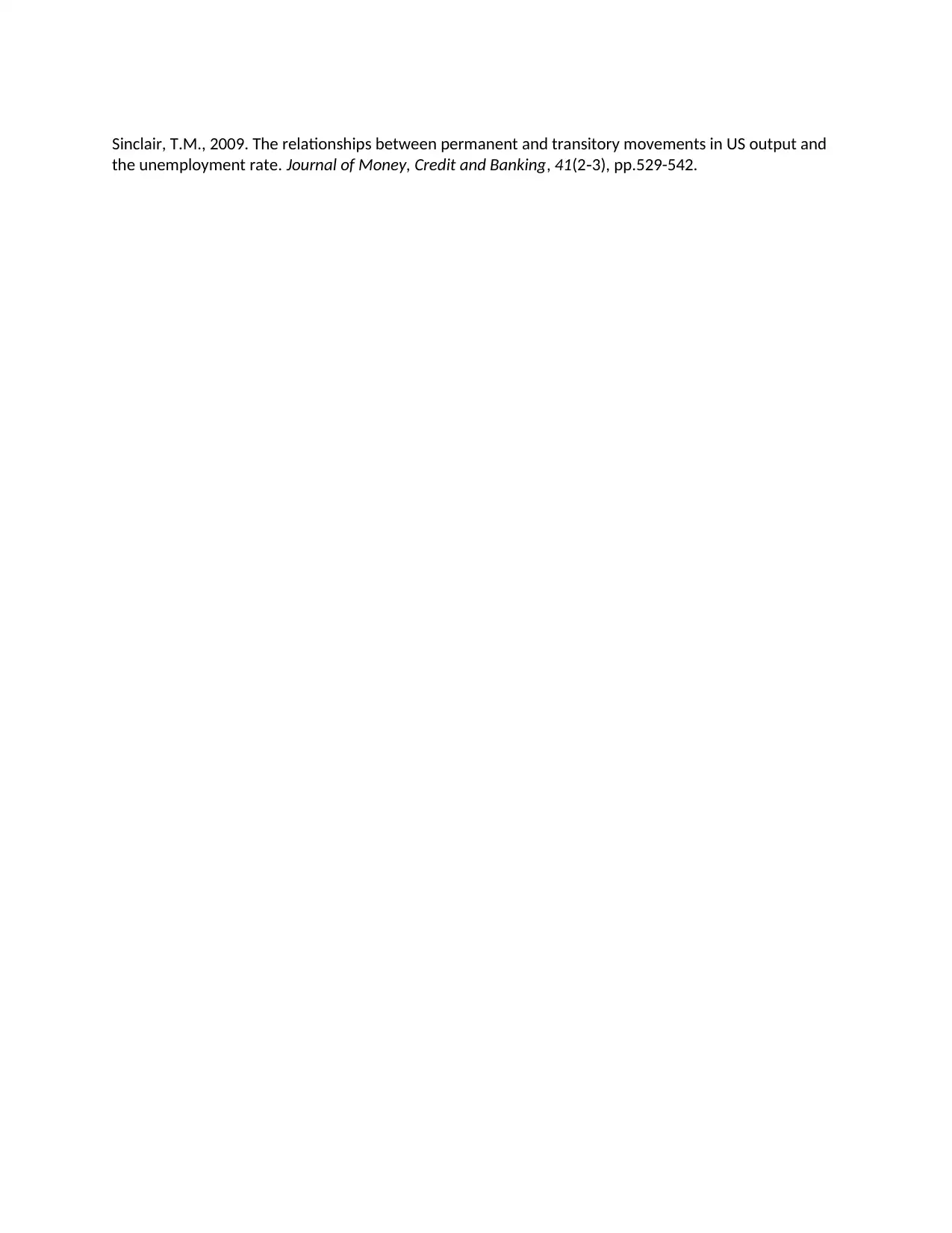
Sinclair, T.M., 2009. The relationships between permanent and transitory movements in US output and
the unemployment rate. Journal of Money, Credit and Banking, 41(2 3), pp.529-542.‐
the unemployment rate. Journal of Money, Credit and Banking, 41(2 3), pp.529-542.‐
1 out of 7
Related Documents
Your All-in-One AI-Powered Toolkit for Academic Success.
+13062052269
info@desklib.com
Available 24*7 on WhatsApp / Email
![[object Object]](/_next/static/media/star-bottom.7253800d.svg)
Unlock your academic potential
Copyright © 2020–2026 A2Z Services. All Rights Reserved. Developed and managed by ZUCOL.




